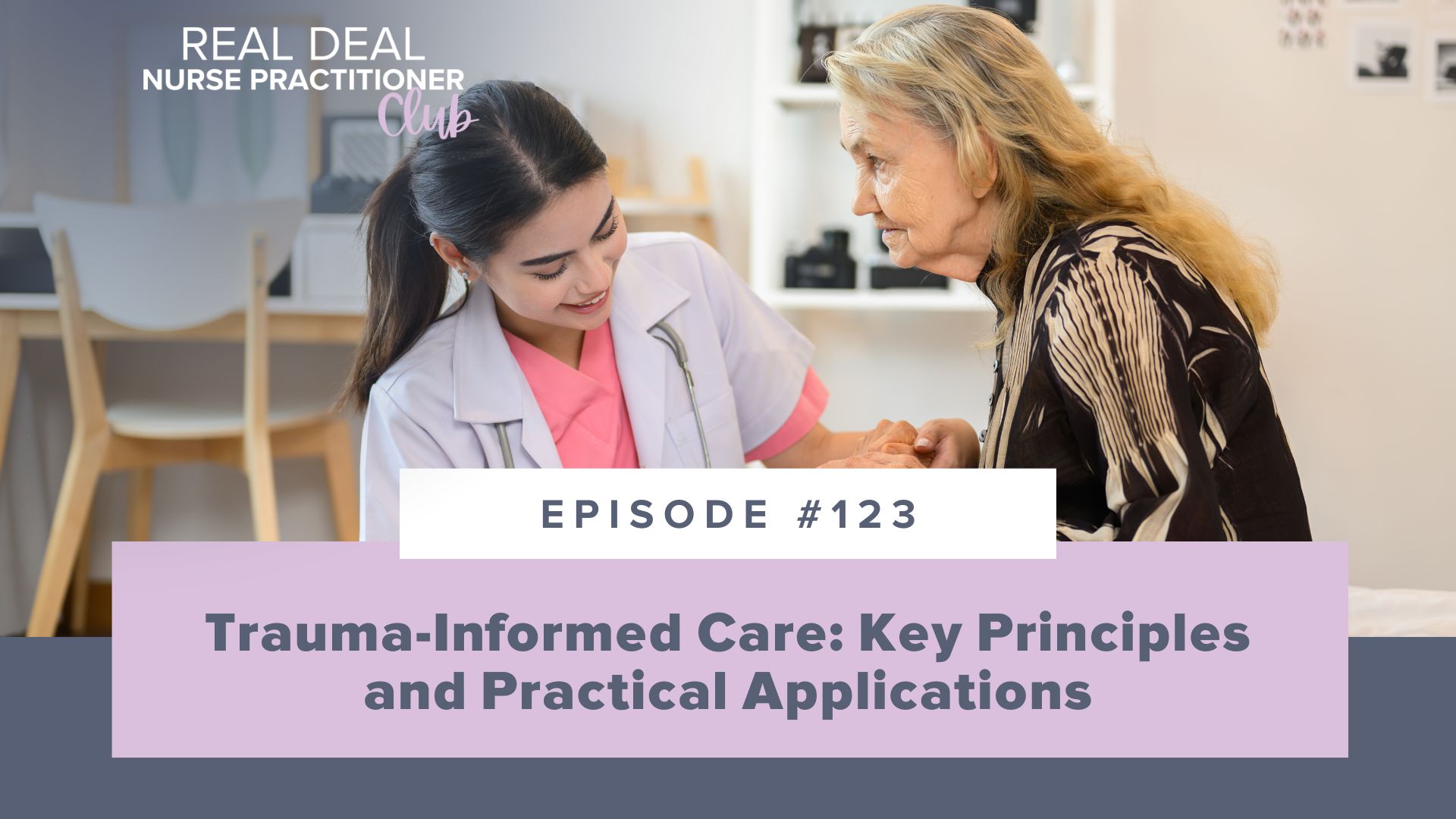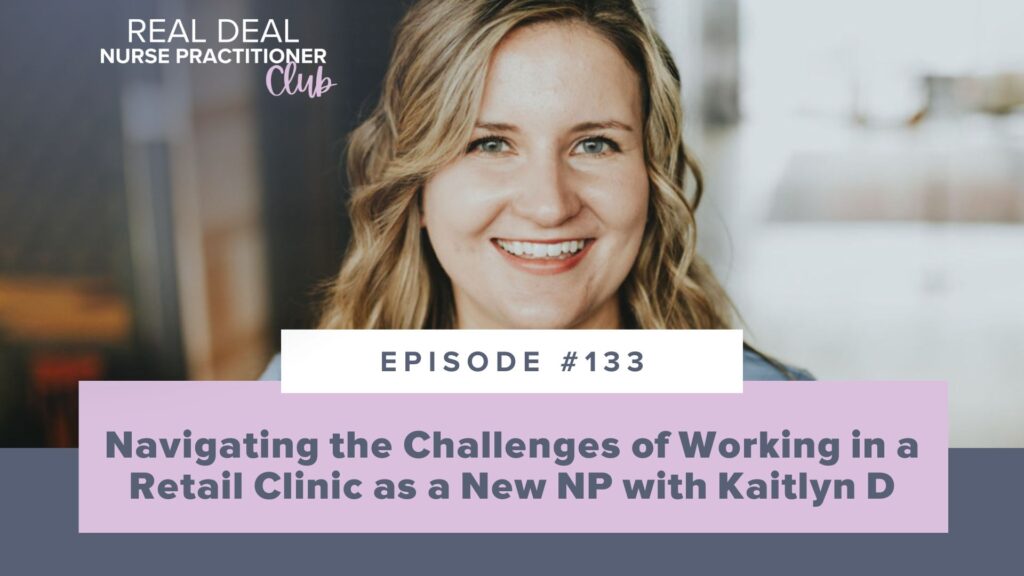Ep #123: Trauma-Informed Care: Key Principles and Practical Applications
- by Sarah Michelle
- Oct 02, 2024
- Podcasts

Have you heard the term “trauma-informed care” being used more frequently lately? In the wake of the COVID-19 pandemic, this approach to healthcare has gained significant attention as a way to better support patients who have experienced trauma.
But what exactly does trauma-informed care entail, and how can we as real-deal Nurse Practitioners integrate it into our practice? If you’re looking to master the basics of trauma-informed care and be equipped with practical strategies you can start implementing in your work, you’re in the right place.
Join us this week as Anna and I dive into the concept of trauma-informed care, exploring its key principles and the steps we can take to create a safe and supportive environment for our patients.
What You Will Discover:
- The definition of trauma and how it relates to healthcare.
- 4 key assumptions of trauma-informed care.
- The 6 guiding principles of trauma-informed care.
- How trauma-informed care can improve patient engagement, health outcomes, and social relationships.
- Practical steps for creating a trauma-informed environment in your clinic or workplace.
Featured on the Show
- Follow me on: Facebook | Instagram | YouTube | TikTok
- Follow us on TikTok and YouTube!
- Check out our Job Hunt Course!
- Trauma-Informed Care Implementation Resource Center
- Substance Abuse and Mental Health Services Administration (SAMHSA)
Full Episode Transcript:

Welcome to the Real Deal NP Club. Whether you’re hoping to become a real deal nurse practitioner or you already are one, this is the place for you to get the resources you need as you tackle this massive transition into practice. We’re your hosts, Sarah Michelle, Chief Nursing Officer of Blueprint Test Prep, and Anna Miller, Director of Nursing Content. And we’re here to hang out with you each week like your best friends in the NP space. Let’s dive in.
Sarah: Hello, friends. Today, Anna and I are going to be talking about something that has been practiced for well over 50 years now, but more recently has become a bit of a buzzword. And so we are going to be talking about trauma-informed care. It is really grown in popularity and exposure, especially in the literature since that COVID-19 pandemic, which could certainly be described as a traumatizing experience for many people across the board. And so we’re just going to talk about how to dive into this approach to care and the steps that we can take as real donors practitioners.
Anna: Yeah, there is a lot of information now on trauma-informed care, but what exactly does that mean? Like what defines trauma or traumatic events? And we’re going to talk about that and how we can use the principles of trauma-informed care to really guide our clinical practice.
Sarah: Before we can talk about trauma-informed care, I think we need to actually define what a trauma is. I think there is a certain connotation with trauma that it is some sort of physical or emotional abuse or impact, but according to the Trauma-Informed Care Implementation Resource Center, trauma is a pervasive problem. It results from exposure to an incident or a series of events that are emotionally disturbing or life-threatening that have lasting adverse effects on the individual’s functioning and mental, physical, social, emotional, and or spiritual well-being.
Anna: Yeah, and trauma can certainly be the result of abuse or physical trauma, but it can occur from poverty, systemic discrimination, or even the sudden loss of a loved one’s, right? Like all of these are traumatic events. So now, how does this relate to health care?
Sarah: But you can think of trauma as a part of social determinants of health. People who have experienced traumatic events, especially those that are repeated traumas, are much more likely to have dysfunctional relationships, use tobacco products, and demonstrate maladaptive coping behaviors as well.
Anna: Yeah, really trauma-informed care, it really just flips the script as a clinician to instead of seeking out what is wrong with the patient, It is asking it in a way that is saying what is happening to the patient and this approach allows the patient to feel safe and helps avoid any re-traumatization.
Sarah: And the Substance Abuse and Mental Health Services Administration states that a trauma-informed practice acknowledges the impact of trauma, the signs and symptoms we might see, and it works to integrate such knowledge of trauma-informed care into all policies and interactions. And this organization has some key assumptions about trauma-informed care known as the four R’s and those are realization, recognize, respond, and resist retraumatization. Anna, can you kind of go over those a little bit.
Anna: Yeah, so realization, right, just means realizing how trauma impacts individuals, and families. Everyone has different coping strategies that help them or not help them to process trauma. Recognize means recognizing the signs of trauma so that we can make appropriate referrals for care and services.
Respond is the ability of the individual and organization to utilize and integrate trauma-informed care into patient care. And then lastly, that resisting re-traumatization means creating an environment that lessens the stressors and assists in the recovery of trauma.
Sarah: And then using those key assumptions, we can move forward with our trauma informed approach using the six principles of safety, trustworthiness, and transparency, peer support, collaboration, mutuality, empowerment, voice and choice, and cultural, historical and gender issues.
So let’s break some of those down a little bit. Safety means creating an environment where patients feel safe both physically and psychologically. And the principles of trustworthiness, collaboration, and empowerment all deal with using open communication, establishing that trust and rapport, and focusing on resilience and healing.
Anna: Yeah, there are a lot of guiding principles to make our patients feel safe. But really, we need to talk about why this matters so much, right? What are these benefits of trauma-informed care? Besides helping patients to heal and overcome trauma, it really comes down to helping patients be more engaged in their care.
Sarah: And when that happens, patient-centered decision-making occurs and patients can experience better health outcomes. It can help to improve social relationships, coping mechanisms, and lessen the burden of chronic disease as well.
And so what are some steps that you can take as a real-deal nurse practitioner to provide that trauma-informed care? Well, there is not really an exact recipe. It takes a lot of training and self-reflection and just motivation to create that positive change. And if you’re interested in more information, definitely check out that organization we discussed before or the Trauma-Informed Care Implementation Resource Center for more information and training resources. And Anna, what are some other ways to communicate in a trauma-informed way.
Anna: Yeah, besides training for you, colleagues, clinical organization, just look at the physical environment. So think about what the space says to patients. Is it an inviting space? And I always recommend practicing this trauma-informed care with your colleagues and staff.
Sarah: Well what do you mean by that?
Anna: Well basically just creating a culture of wellness. So think about is your work environment solely focused on meeting company goals? Or are the needs of the employees taken into consideration as well? Are employees using time off to rest and rejuvenate? Does your company offer paid time off for mental health days? Those are all huge.
Sarah: And along those lines too, you can start to incorporate wellness practices into the workday. So that could look like having a brief check-in session every morning to talk about any stress or to kind of refocus group needs.
Or another idea could be to encourage staff to take their lunch and breaks away from their desk or their workstations and kind of give them the opportunity to unplug a little bit. And so trauma-informed care might have been a new topic for you today, but we hope that you can walk away from this quick episode with just a basic understanding of its importance because that’s the first step. And Anna, is there anything else you’d want someone to take away?
Anna: I think the big thing for today, we’re just barely scraping the surface, but the big thing is that we want to create a safe and welcoming environment for our patients, right? That’s what it boils down to. And like what was said earlier, it’s not about figuring out what’s wrong with the patient. It’s what has happened to the patient. Learning this trauma-informed approach, it takes time, but it is well worth it.
Sarah: Yes. And definitely check out those resources we’ve mentioned, especially like if your clinic hasn’t really deep dived into trauma-informed care, maybe you’re the person that can bring it to the surface and it will be abundantly helpful for your patients. But that is it for this week and we’ll be talking to you soon.
Thanks for listening to the Real Deal Nurse Practitioner Club. If you want more information about the different types of support that we offer to students and new nurse practitioners, you can visit npreviews, with an S, dot com. We’ll see you next week.
Enjoy the Show?
- Don’t miss an episode: follow the podcast on Spotify, Apple Podcasts or RSS.
Related Posts
Search the Blog
Join our Facebook Group!
Get FREE support and encouragement from thousands of FNP/AGPCNP students and our NP Support team.
Learn More3 Study Hacks to Conquer Your NP Exam!
Download these tips that have helped thousands of students pass their NP board exams.
Download NowInstitutional Partnerships
Are you a faculty member and would like to bring Sarah Michelle’s resources to your school? Email us at nursinggroups@blueprintprep.com for special institutional pricing or click on the link below to learn more.
Learn MoreGroup Discounts
Are you a student and have 10 or more classmates interested in purchasing Sarah Michelle’s courses? Email us at nursinggroups@blueprintprep.com for special pricing.



